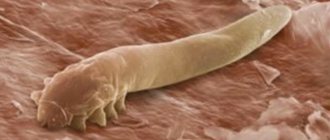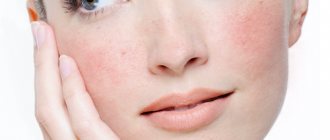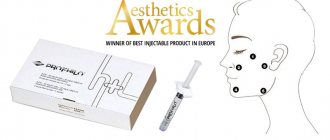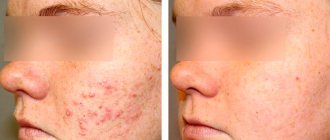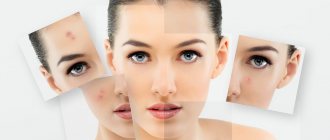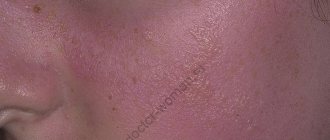Mite
The subcutaneous mite causes skin lesions in humans and animals - demodicosis. The mite settles in the hair follicles of the head, eyelashes and eyebrows, in the ducts and secretions of the sebaceous glands of the facial skin. A subcutaneous mite is a normal phenomenon, and for the time being it does not pose a danger, since it feeds on waste cells. But if the body’s defenses weaken, the mite begins to actively multiply, penetrates into the deeper layers of the skin and causes inflammation. According to the observations of researchers, women are more often affected by this disease.
FACT:
It is believed that more than 20% of people are carriers of demodicosis, but no clinical signs are detected.
Causes of demodicosis
In a healthy person, the activity of the Demodex mite is suppressed by the body's immune defense. With a decrease in immunity, there are more ticks, which leads to the development of demodicosis. Also, an increase in the number of mites can be caused by metabolic disorders. Demodex feeds mainly on the secretions of the sebaceous glands, so increased productivity of the sebaceous glands leads to the activation of mites and, as a consequence, manifestations of demodicosis.
Thus, the list of the main reasons for the development of demodicosis may look like this:
- decreased general immunity;
- stress factors (stress and negative emotions contribute to decreased immunity);
- chronic diseases leading to a decrease in the protective ability of the skin;
- increased skin oiliness;
- hormonal changes (in particular during adolescence, when as a result of such changes the viscosity of the secretion of the sebaceous glands increases);
- use of cosmetics with hormonal supplements;
- failure to comply with personal hygiene rules.
Signs of illness
In its manifestations, damage to the subcutaneous mite is very similar to rosacea or acne. Peeling of the skin and its redness are noted, itching may occur, constant or worsening after using tonics or washing with cold water. Sometimes there is a combination of demodicosis caused by subcutaneous mites and the above-mentioned skin diseases. And this is not surprising, because the occurrence of demodicosis is influenced by negative changes in the skin. Thus, both acne vulgaris and rosacea weaken the skin’s natural defenses. When affected by skin mites, the following parts of the face are most often affected: eyelids, forehead, chin, nasolabial folds and brow ridges. Exacerbations of demodicosis occur in autumn and spring.
Hormonal acne
02.08.2021
Hormonal acne is a form of acne . It primarily affects adult women. The disease is associated with the functioning of the endocrine system and periodic changes in hormone . Hormonal acne can be treated with medications and natural methods
Acne is primarily associated with a temporary problem during adolescence, when the concentration of sex hormones in the body changes. Unfortunately, more and more cases of this skin disease are being found in adults, especially women between the ages of 25 and 35. This type of condition is known as hormonal acne . His treatment is carried out by a dermatologist and endocrinologist . Specialized therapy is supported by home and natural methods.
Hormones and acne
Various types of dysfunction of the endocrine system , consisting of an increase or decrease in the concentration of certain hormones , contribute to increased work of the sebaceous glands and hyperproduction of sebum. As a result, the ducts that carry secretions out are blocked, and painful pustules, papules and nodules appear on the skin of the face , neck , back and décolleté. These symptoms are known as hormonal acne or adult acne
The hormones that cause acne are primarily androgens (male sex hormones ) - testosterone, dihydrotestosterone and androstenediol. However, sometimes it is the increase in the concentration of estrogens ( female sex hormones ) that causes skin changes to appear. Their rapid concentration occurs before menstruation or during menopause . For this reason, women over 25 years of age are most often affected. Hormonal acne in men is rare.
It should be noted that endocrine , excess sebum production and hormonal acne in adults: genetic predisposition, long-term stress, improper skin care, stimulants and diet .
Symptoms of hormonal acne
Symptoms of endocrine acne largely depend on which hormones contribute to the onset of the disease. Androgens cause large and painful bumps and blackheads on the skin of the face (forehead, chin, jawline), neck and back . The complexion is also oily and shiny, skin lesions rarely become inflamed. When estrogen is responsible for acne , rashes appear nose They appear as burning or itchy spots and bumps. Their occurrence is preceded by redness of the central part of the face as a result of vasodilation .
Hormonal tests for acne
Hormonal tests for acne should be taken before starting treatment. The order is issued by the attending physician - a dermatologist or endocrinologist . They are carried out in the morning in the laboratory . For women, the day of the menstrual cycle is important. The test involves taking a blood . Test results are usually available the next business day.
The following tests are usually prescribed for adults:
- total testosterone;
- without testosterone;
- dehydroepiandrosterone (DHEA);
- thyroid hormones ;
- prolactin;
- follicle-stimulating hormone (FSH);
- luteotropic hormone (LH);
- insulin.
How to treat hormonal acne?
Hormonal treatment for acne is selected individually for each patient. Therapy is long-term - usually several months. Most often it involves the use of oral medications and local pharmacological agents in the form of creams and ointments.
Acne can be treated with antibiotics or retinoids (vitamin A derivatives). Both drugs are very strong and should only be taken under medical . Sometimes the decision is made to add birth control pills. Acne hormones balance the endocrine system .
Hormonal treatment for acne is ineffective if the skin is not properly cared for at the same time. People suffering from this condition should use ethanol-free cosmetics designed for acne -prone skin. The face should be cleansed and then moisturized. Regular removal of excess sebum and exfoliated epidermis improves skin condition and prevents the formation of new changes.
Diet for hormonal acne
Diet can have a significant impact on the appearance of your skin. The diet for hormonal acne should be rich in vitamins and nutrients that support the regenerative processes of the epidermis. The menu must include foods high in vitamins A, E, C and B, as well as zinc and selenium. It is not recommended to eat processed foods, fast food, hot spices and foods with a high glycemic index.
Published in Dermatology Premium Clinic
Risk factors
As mentioned above, what is unpleasant is not the presence of a subcutaneous mite as such - in itself it cannot harm a healthy person - but demodicosis, which is caused by a mite. If the body is weakened and there are additional risk factors, the tick can settle in the skin for a long time and cause considerable mental and physical damage to its “breadwinner”. Risk factors include:
- dysfunction of the sebaceous glands, changes in the composition of sebum, vascular changes;
- some skin diseases (rosacea, acne, seborrhea);
- long-term use of hormonal corticosteroid ointments;
- adolescence;
- pregnancy;
- stress.
Unfortunately, non-specialists react with unacceptable ease to the appearance of acne on the face and body. The appearance of such problems is attributed to age and ordinary acne, which sooner or later should disappear on their own. We have to disappoint you: demodicosis caused by subcutaneous mites will not go away on its own. The disease can travel from one area of the skin to another, existing for years and ruining the life of its “donor”.
IMPORTANT:
squeezing out acne when infected with a subcutaneous mite only leads to an exacerbation of the infection, since during this process the mites are pressed into healthy areas of the skin and infect them.
Make an appointment
What then is possible?
To begin with, we should say what is needed - a dietary regimen during and after treatment. What about cosmetic procedures? Some of them are a real salvation in the fight against demodicosis. They help restore infected areas of the skin:
- cryotherapy - cold exposure, causing a sharp spasm of blood vessels followed by persistent dilation; result - peripheral blood supply is enhanced, skin nutrition is improved, metabolic processes are accelerated, the immune system is activated, and the skin's resistance to stress increases;
- mesotherapy - carried out during the period of remission, this is an injection procedure, the essence of which is the delivery of restorative substances contained in the preparations / cocktails to the tissues;
- plasma therapy - carried out during the period of remission, this is the introduction of purified and platelet-rich blood plasma of the patient into the affected areas of the skin; As a result, skin immunity is stimulated, and regeneration processes are launched at the cellular level.
Each of the procedures described above is prescribed in a course; to achieve a sustainable effect, on average, 5–6 procedures are required, which are carried out every 7 days.
Treatment
Treatment of demodicosis caused by subcutaneous mites is a long and difficult process. Its complexity is that often this disease develops against the background of a decrease in the body’s defenses and has accompanying skin problems. Therapy tactics include suppressing the parasite, treating underlying diseases and increasing immunity.
The most commonly used local therapy is lotions and special ointments. In more severe cases, the doctor prescribes a course of antibiotics in combination with external therapy. Sometimes plasmapheresis procedures are recommended. In special cases, even surgical intervention is possible.
An important point in the course of treatment is diet. It is necessary to exclude hot, spicy and salty foods, foods rich in carbohydrates and fats from the diet. Those who are being treated for subcutaneous mite infestation are recommended to consume large amounts of fruits, vegetables, microelements, fiber, and dairy products. During treatment, you should not use face masks, especially those containing honey. You need to limit your exposure to the sun. You should also wait until better times to visit the bathhouse and sauna.
